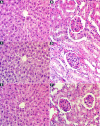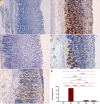In Vivo Gastroprotective Upshots of the Novel Schiff Base CdCl2 (C14H21N3O2) Compound by Bax/HSP-70 Signaling and Inflammatory Cytokines
- PMID: 39830532
- PMCID: PMC11741513
- DOI: 10.7759/cureus.75963
In Vivo Gastroprotective Upshots of the Novel Schiff Base CdCl2 (C14H21N3O2) Compound by Bax/HSP-70 Signaling and Inflammatory Cytokines
Abstract
Background: Synthesis of the original Schiff base CdCl2 (C14H21N3O2) compound (Schiff base complex) displays an extensive range of bioactivities and was predictably utilized to treat several syndromes.
Purpose: The goal of the existing experiment is to evaluate the gastroprotective effects of a novel Schiff base CdCl₂ (C14H21N3O2) compound in alcohol-induced gastric ulcers in rats by examining its antioxidant activity, anti-inflammatory effects, and modulation of key molecular markers, including heat shock protein-70 (HSP-70) and Bcl-2-associated X protein (Bax) proteins.
Methods: Five groups of rats were utilized in the current study. Control and model groups were orally administered 10% Tween 20. The treated groups were orally administered 20 mg/kg omeprazole or Schiff base compound (25 or 50 mg/kg). One hour later, only the control group received oral 10% Tween 20, and the treated groups received oral (5 ml/cage) absolute alcohol. During the second hour, all rats were sacrificed.
Results: All treated rats presented considerable improvement in alcohol-induced gastric injury recognized by decreasing ulcer index and raising % of ulcer inhibition. Increased mucus and gastric pH content and decreased ulcerated portion, reduced or non-appearance of edema, and leucocytes penetrated the subcutaneous layer. In stomach epithelium homogenate, the Schiff base compound obtainable significant upsurge superoxide dismutase (SOD), catalase (CAT) activities, considerable declining malondialdehyde (MDA) quantity. Moreover, the Schiff base compound raised the intensity of periodic acid-Schiff (PAS) stains gastric epithelium. Furthermore, the Schiff base compound formed up-regulated HSP-70 and down-regulated Bax proteins gastric epithelium Schiff base compound, reduced the level of tumor necrosis factor-alpha (TNF-α), interleukin-6 (IL-6) and improved the quantity of IL-10. Administering a high dose of 500 mg/kg Schiff base compound revealed the nontoxic nature of the compound in rats.
Conclusion: Schiff base compound exhibited gastroprotective effects attributed to its antioxidant nature, its capability to enhance mucus excretion, SOD and CAT, reduce MDA amount, up-regulate HSP-70 protein, down-regulate Bax protein, and inflammatory cytokines.
Keywords: bax; gastric ulcer; histopathology; hsp-70; il-10; il-6; immunohistochemistry; novel schiff base cdcl2 (c14h21n3o2) compound; tnf-α.
Copyright © 2024, Shareef et al.
Conflict of interest statement
Human subjects: All authors have confirmed that this study did not involve human participants or tissue. Animal subjects: The research was conducted following the ARRIVE guidelines and in conformity with guidelines proven by Iraqi animal rights and national scientific recommendations for laboratory animal experiments. The present animal procedure was approved by the Research Ethics Committee of Cihan University, Erbil, Kurdistan region, Iraq. Issued protocol number ERB 89/09/5/2024/MAA. Conflicts of interest: In compliance with the ICMJE uniform disclosure form, all authors declare the following: Payment/services info: All authors have declared that no financial support was received from any organization for the submitted work. Financial relationships: All authors have declared that they have no financial relationships at present or within the previous three years with any organizations that might have an interest in the submitted work. Other relationships: All authors have declared that there are no other relationships or activities that could appear to have influenced the submitted work.
Figures









References
-
- Effect of nano silver on gastroprotective activity against ethanol-induced stomach ulcer in rats. Ibrahim IA, Hussein AI, Muter MS, et al. Biomed Pharmacother. 2022;154:113550. - PubMed
-
- Gastroprophylactic effects of p-cymene in ethanol-induced gastric ulcer in rats. Shareef SH, Al-Medhtiy MH, Ibrahim IA, et al. Processes. 2022;10:1314.
-
- Green synthesis of gold nanoparticles using Zingiber officinale rhizomes aqueous extract and its gastroprotective activity against ethanol-produced stomach ulcer in rodents. Shareef SH, Hadi IN, Badeea MA, et al. CUESJ. 2022;6:68–75.
LinkOut - more resources
Full Text Sources
Research Materials
Miscellaneous
